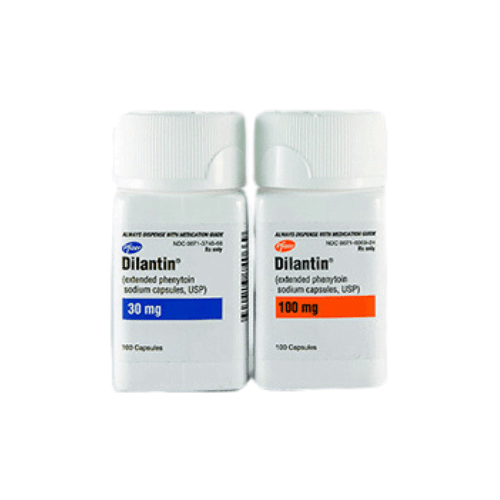Shipping with this method takes 3-5 days
Dilantin® Capsules for Seizures
Stock up and Save - Get 20% off when you buy 3 or more of any one product. Use code SAVE20 at checkout.
Coupon code cannot be combined with other offers. Sale applies to all products originating from Canada. Maximum allowable quantity equal to a 90 day supply per single order.
Price range: $46.99 through $54.99
Secure Encrypted Payments
What Dilantin Is and How It Works
Dilantin® is an anti-seizure medicine used to help control certain types of epilepsy. It works by stabilizing electrical activity in the brain to reduce seizure frequency. This page explains practical use, safety, and access for your prescription. Ships from Canada to US options are available, including support for Dilantin without insurance. YouDrugstore is a licensed Canadian pharmacy in Manitoba. Pharmacists review prescriptions before dispensing.
Phenytoin, the active ingredient, reduces sustained high-frequency firing of neurons. It modulates voltage-gated sodium channels and helps prevent seizure spread. The treatment has been used for decades and remains a standard option when clinically appropriate.
Who It’s For
This therapy is used to prevent and control generalized tonic-clonic and focal seizures. It may be used alone or with other anti-seizure medicines when your prescriber recommends combination therapy. People with known hypersensitivity to hydantoins should avoid it. Those with certain heart rhythm issues, severe liver disease, or porphyria may not be good candidates. Discuss the generic name for phenytoin and brand options with your clinician before starting, especially if you are pregnant, planning pregnancy, or nursing.
Dosage and Usage
Use exactly as directed on your prescription label. Take doses at the same times every day to maintain steady blood levels. Swallow capsules whole with water. If your prescriber switches you between formulations, follow their guidance closely and schedule monitoring if requested.
Take with food if stomach upset occurs, though food is not required for everyone. Avoid sudden discontinuation. Stopping abruptly can increase seizure risk. Your healthcare professional may order periodic blood tests to assess levels and safety. Keep all lab appointments and follow the dosing schedule provided in your prescription instructions.
If you receive new medicines, vitamins, or herbal products, ask a healthcare professional or pharmacist to check for interactions before you start them.
Strengths and Forms
Availability can vary by manufacturer and market. Common presentations include extended-release capsules and chewable tablets. The suspension is used when liquid dosing is preferred by the prescriber. We also list different package sizes when available. In some cases, Dilantin tablets or chewables are chosen for patients who cannot swallow capsules. Talk with your prescriber about which form best fits your needs and monitoring plan.
Typical published strengths for this class include:
- Extended-release capsules: 30 mg and 100 mg
- Chewable tablets: 50 mg
- Oral suspension: 125 mg per 5 mL
Note: product availability, labeling, and appearance differ by country and supplier. Always check your bottle for the exact strength and form dispensed.
Missed Dose and Timing
If you miss a dose, take it when remembered unless it is close to the next scheduled time. If it is nearly time for the next dose, skip the missed one and resume your regular schedule. Do not double up. If you miss more than one dose, contact your prescriber or pharmacist for guidance. Consistent timing helps maintain stable levels and more reliable seizure control.
Storage and Travel Basics
Store at room temperature away from excess heat and moisture. Keep the container tightly closed and out of reach of children and pets. Do not use after the expiration date on the label. For travel, carry your medicine in original packaging with your prescription label. Pack it in your carry-on bag and bring a copy of your prescription or a doctor’s note if needed. Use a reminder system during travel to keep doses on schedule across time zones.
Benefits
This medicine can help reduce the frequency and severity of certain seizures when taken as prescribed. The extended-release form is designed for steady blood levels, which may support consistent control. Having multiple forms allows prescribers to tailor therapy to swallowing needs, age, and monitoring plans. Long clinical experience and lab monitoring frameworks can support safe and informed use.
Side Effects and Safety
- Common: dizziness, drowsiness, unsteadiness, headache
- Gastrointestinal: nausea, vomiting, constipation
- Neurologic: nystagmus, slurred speech, tremor
- Dental: gingival overgrowth; good oral hygiene is important
- Skin: mild rash may occur; seek care for severe reactions
Serious but less common effects can include severe rash such as Stevens-Johnson syndrome or toxic epidermal necrolysis, liver problems, blood disorders, confusion, mood changes, and heart rhythm disturbances. Seek urgent care for widespread rash, facial swelling, trouble breathing, unusual bruising, yellowing of the skin, or worsening mood or behavior. Lab monitoring is often recommended to help manage safety and effectiveness.
Drug Interactions and Cautions
This therapy is known to interact with many medicines. It can affect or be affected by anticoagulants, certain antidepressants, antiretrovirals, antifungals, some antibiotics, and hormonal contraceptives. It may reduce the effectiveness of estrogen- or progestin-containing birth control. Alcohol use can alter levels and increase side effects. Enteral feeding can change absorption; your clinician may adjust timing relative to tube feeds. Always inform your prescriber and pharmacist about all medicines and supplements you take. Do not change manufacturers or dosage forms without clinical guidance.
What to Expect Over Time
Your clinician may adjust the dose during early treatment and request blood tests to reach a therapeutic range. Seizure control can vary, and the goal is to reduce frequency and severity while minimizing side effects. If you feel unsteady or sedated, talk to your prescriber; adjustments or timing changes may help. Keep a seizure and side-effect diary to support follow-up discussions. Consistent adherence, regular dental care, and routine monitoring visits are important for long-term use.
Compare With Alternatives
Other prescription options may be appropriate depending on seizure type, age, comorbidities, and interactions. Two commonly used alternatives include Keppra® and Lamictal®. Your clinician will choose based on your medical history, response, and monitoring needs. Different medicines have distinct interaction profiles and adverse effect patterns, so patient-specific guidance is essential.
Pricing and Access
Patients sometimes compare brand and generic options to manage costs. If you plan to Buy phenytoin online, review our checkout and see available package sizes. We highlight availability and typical cash-pay savings when possible. Many find Dilantin Canadian pricing competitive for long-term therapy. For coupons and seasonal offers, check our Promotions page. We provide transparent listings with US shipping from Canada noted on each eligible item page.
Availability and Substitutions
Supply can change by manufacturer and strength. If your first choice is unavailable, your prescriber may recommend a suitable alternative or generic formulation. Ask your clinician about the Generic for Dilantin when appropriate. Prescription required and verified before dispensing. If your therapy changes, you may need follow-up and lab checks to confirm target levels and tolerability.
Patient Suitability and Cost-Saving Tips
Not every patient is a good candidate. Those with certain heart conditions, serious liver disease, or a history of severe rash to hydantoins should discuss other options. Tell your prescriber about all medicines and supplements, and mention past reactions. Patients who may benefit include adults and adolescents with focal or generalized tonic-clonic seizures where this class is indicated and monitoring is feasible.
To reduce out-of-pocket costs, consider larger fills if prescribed, such as 60- or 90-day supplies, to cut per-bottle expenses. Sign up for refill reminders so you do not run out unexpectedly. Patients paying cash sometimes explore Phenytoin without insurance to compare total expenses across pharmacies. Always factor in clinician visits and lab monitoring when planning your budget.
Questions to Ask Your Clinician
- Seizure type fit: Is this therapy right for my seizure pattern?
- Monitoring plan: How often will levels and labs be checked?
- Formulation choice: Capsule, chewable, or liquid for my needs?
- Interactions: Which medicines or supplements should I avoid?
- Family planning: What are the pregnancy and contraception considerations?
- Safety: What symptoms should prompt urgent medical attention?
- Driving and work: When is it safe to resume daily activities?
Authoritative Sources
Health Canada Drug Product Database
Pricing and Access Resources
Learn more about related conditions in our Seizures section, or browse the broader Neurology category. For background reading, see Epilepsy When The Brain Goes Crazy But The Person With The Brain Isnt, What Are Migraine Headaches Are They A Type Of Epilepsy, and World Brain Tumor Day Support Hope And Action.
Ready to proceed? Place your order with prompt US delivery from Canada and encrypted checkout, with temperature-controlled handling when required. This page is informational and not a substitute for medical advice; always follow your prescriber’s directions.
Express Shipping - from $25.00
Prices:
- Dry-Packed Products $25.00
- Cold-Packed Products $35.00
Shipping Countries:
- United States (all contiguous states**)
- Worldwide (excludes some countries***)
Standard Shipping - $15.00
Shipping with this method takes 5-10 days
Prices:
- Dry-Packed Products $15.00
- Not available for Cold-Packed products
Shipping Countries:
- United States (all contiguous states**)
- Worldwide (excludes some countries***)
Can I switch between capsules, chewables, and liquid?
Switching formulations should be guided by your prescriber because absorption can differ between forms. Some products are extended-release, while chewables and liquids are immediate-release. Changing form or manufacturer may alter drug levels and seizure control. Your clinician may order lab tests after a switch to confirm the new regimen is appropriate. Do not change products on your own without clinical approval and instructions.
Do I need regular blood tests while on this medicine?
Your prescriber may request blood tests to check levels and safety, especially during dose adjustments or if side effects occur. Monitoring can help balance seizure control with tolerability. Frequency depends on your clinical situation, other medicines, and overall health. Keep all follow-up appointments and lab visits, and tell your clinician if you notice new symptoms or changes in seizure frequency.
What should I avoid while taking phenytoin?
Alcohol can affect levels and side effects, so moderation and clinician guidance are important. Some antibiotics, antifungals, antiretrovirals, antidepressants, and anticoagulants can interact. This medicine may reduce the effectiveness of hormonal birth control. Enteral feeds can alter absorption, so timing may need adjustment. Always ask a pharmacist or prescriber to review new medicines, vitamins, or herbal products before you start them.
How quickly will my seizures improve?
Response varies. Your clinician may adjust the dose over time and request blood tests to reach a therapeutic range. The goal is to reduce frequency and severity while minimizing side effects. Keep a seizure diary to track patterns and report changes at follow-up visits. Because responses differ, avoid expectations for specific timelines and continue taking the medicine as directed unless told otherwise.
Can I drive while taking this treatment?
Driving rules for people with epilepsy vary by region. If you have had recent seizures or feel sedated, dizzy, or unsteady, avoid driving and operating machinery. Discuss local regulations and your clinical status with your prescriber. They can advise when it may be appropriate to resume driving based on your control and any side effects. Safety comes first for you and others on the road.
Is this medicine safe during pregnancy?
Management during pregnancy is individualized. Some anti-seizure medicines carry known risks, and uncontrolled seizures pose dangers too. If you are pregnant or planning to become pregnant, speak with your clinician before making any changes. Folic acid and careful monitoring are often considered. Do not stop your medicine suddenly. Your healthcare professional will weigh benefits and risks and may adjust treatment.
What if I develop a rash or gum changes?
Mild rashes can occur, but severe skin reactions require urgent attention, especially if you see blistering, peeling, or facial swelling. Report any new rash to your clinician. Gum overgrowth can happen with long-term use, and good oral hygiene plus regular dental care may help. If dental changes worsen or impact daily life, ask about strategies and whether your therapy should be re-evaluated.


